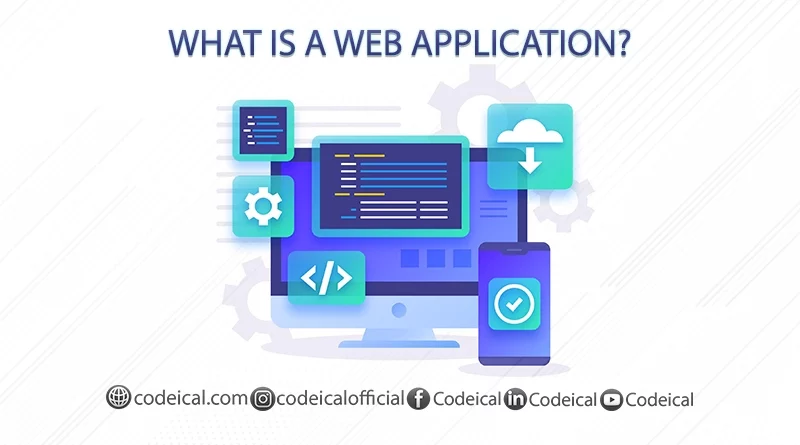What Is a Web Application?
In the present digital landscape, an intriguing phenomenon has emerged: a substantial proportion of the websites we engage with on the internet are, in reality, web applications. These web applications are the virtual tools we employ via our web browsers to carry out an array of tasks. Whether we’re checking our emails, uploading and sharing vacation snapshots, sending birthday wishes to friends, or bookmarking our preferred online content, we are actively engaging with these versatile web-based tools.
But what precisely constitutes a web application, and what sets them apart from traditional websites from a technical perspective? To grasp this distinction, it’s essential to delve into the inner workings of web applications.
Web applications encompass two fundamental components: the user interface, often referred to as the client, and the back-end infrastructure. The client, which represents the front-end aspect of the web application, is what users see and interact with when they access the application.
Complementing the front-end is the back-end, a critical part of the web application that operates behind the scenes. The back-end typically consists of a server-based database where user data is stored, processed, and retrieved. This intricate interplay between the client and server forms the foundation of web applications and is the underlying mechanism that powers the functionality of your beloved web-based tools.
If you’re intrigued by the inner workings of web applications and harbor the desire to create one of your own, this comprehensive post is tailored to your needs. Throughout this article, we will explore the fundamental principles governing web application development, shedding light on their construction and functionality. Most importantly, we will guide you through the initial steps to embark on your journey of crafting your web applications.
So, without further ado, let’s embark on this enlightening exploration of web applications and equip you with the knowledge and tools to embark on your own web application development journey. Happy reading and get ready to unleash your creativity in the realm of web application design and development!
What we will cover in this post
I first got interested in programming because I wanted to create my own web apps in the future. That’s why in this post I’ll share with you a bit of what I’ve learned about web apps, going through the following points:
What is a web application?
Web applications and traditional websites exhibit disparities in the content they present to users. These distinctions, however, do not create a strict dichotomy, often blurring the lines between the two, making it challenging to discern where one entity concludes and the other commences.
Consequently, these variances highlight the evolving nature of online platforms, with web applications offering dynamic, interactive, and user-centric experiences, while conventional websites predominantly deliver static information.
The continuous convergence of features and technologies between these two realms underscores the ongoing transformation of the digital landscape.

As a result, the demarcation between web applications and traditional websites remains increasingly fluid, reflecting the adaptability and innovation within the online ecosystem.
A conventional website remains inherently static in nature.
Consider a news page as an illustration. It offers a collection of articles highlighting the most significant and up-to-the-minute global happenings. Alongside this, there are specialized sub-pages dedicated to various news categories like politics or culture. Despite these divisions, the content made available to every reader remains fairly consistent, ensuring a uniform experience for all. This uniformity guarantees that everyone stays well-informed, irrespective of their individual interests or preferences.
In contrast, web applications possess the capability to receive user input and respond dynamically, adapting to their interactions with a heightened level of responsiveness and interactivity.
A straightforward illustration can be found in nearly any website that offers user profiles and login functionality.
Upon successfully logging into your account, the website undergoes a transformation. It displays a personalized interface, showcasing your profile, social media connections, and updates from individuals within your network. The site’s appearance and content become distinctive to your user account.
The central distinguishing feature of web applications lies in their capacity to handle user input. These applications possess the capability to store, retrieve, and present data within a web browser, thereby facilitating user interaction.
One might argue that traditional websites primarily cater to content consumption, while web applications are specifically designed to foster user engagement. Does this concept resonate with you?
How do web applications work?
Now, it’s essential to understand that a web application must incorporate a database to efficiently store all user-generated data. This critical server-side functionality is meticulously crafted by back-end developers, who are responsible for ensuring the seamless operation of the application’s data handling.
On the other side of the spectrum, the client-side responsibilities fall under the purview of front-end programmers. They are tasked with creating an appealing, user-friendly, and highly functional interface for the web application.
So, let’s delve into what precisely resides within this database. You can think of a web application’s database as having an impeccable memory; it never forgets any action or interaction you perform while using it.
Every status update, photo upload, or any other input on your social media account has its own dedicated space within the database. Moreover, the database meticulously records every like, comment, and even likes for comments. It also holds your personal information and your network of friends, along with a comprehensive history of every click you’ve made since you first registered.
Consequently, the volume of data stored by some of the largest web applications we encounter is truly monumental. This is especially prominent in the realm of social media, where user behavior is tracked in exquisite detail.

For a web application of this magnitude, constructing an efficient data structure to manage this colossal amount of data is arguably the most paramount task for back-end developers. The intricacies of data management are particularly significant in ensuring the application’s performance and responsiveness to user interactions.
Typical web app framework structure: Model-view-controller (MVC)
Numerous solutions and diverse approaches exist for establishing the foundational components of a web application from a programming perspective. Up to this point, my experience has predominantly revolved around utilizing Python and Django for the development of my basic web applications. These applications adhere to the widely embraced Model-View-Controller (MVC) architectural pattern, which is one of the most prevalent framework paradigms in the field of web development. Exploring this landscape offers a multitude of possibilities and room for creative implementation.
The MVC pattern effectively splits the backend processes into three interconnected components, each serving a distinct purpose.
- Model: Overseeing the data and application logic with precision and efficiency is the primary responsibility.
- View: Designs and develops the user interface to enhance user experience.
- Controller: Directs the initial two components and manages the coordination of tasks between them effectively.
How does the MVC pattern work?
When utilizing a web application, such as when you log into your social media account, your interaction is primarily with the “view” component. This “view” component effectively communicates your input, including your username and password, to the “controller,” which possesses a clear understanding of how to handle this information.
The “view” subsequently conveys instructions to the “model,” specifying what data it should retrieve from the database. Naturally, the ultimate goal is to reach your landing page upon logging in, and this is where the “model” comes into play. It updates the “view,” causing it to render your landing page within your web browser.
Remarkably, this entire process occurs almost instantaneously, showcasing the remarkable speed of modern technology.
In reality, a social network web application comprises a multitude of distinct applications running in the background. One application may be responsible for user account management, while another oversees the handling of the photos you upload. A third application might handle the processing and maintenance of comments associated with those photos.
The structure of the Model-View-Controller (MVC) framework and the interactions between its components are, naturally, open to varying interpretations and implementations.
This video provides an exceptionally insightful elucidation of the MVC (Model-View-Controller) pattern. It draws a vivid analogy, likening the view to an affable and well-dressed sales clerk who frequently seeks the assistance of the assertive controller. The controller, being well-versed in its business operations, efficiently transfers the request to the model, a resourceful employee located within the storage room. The model possesses the expertise required to precisely retrieve the desired information and promptly conveys it to the sales clerk, who subsequently delivers it to the eager customer, offering a seamless and efficient transaction process. This captivating explanation serves as a valuable resource for those seeking to grasp the intricacies of the MVC pattern.
Web applications vs desktop software
In the evolving landscape of digital technology, web applications not only enrich websites with enhanced features but also open exciting horizons for traditional desktop software developers.
Once upon a time, software resided solely on users’ hard drives, encompassing applications for emails, text editing, and spreadsheet tasks. Today, a significant transformation has occurred. We now manage our email accounts through web browsers, and web-based applications facilitate our spreadsheet and text processing requirements. This transition not only grants us the flexibility to access our documents across multiple devices and platforms but also alleviates the need for intricate software installations.
For software developers, this paradigm shift brings a considerable advantage. They need only develop code for a single platform, significantly simplifying their workload. Consequently, this streamlined approach offers efficiency and effectiveness in the ever-evolving world of software development.
Final thoughts: Develop your own web apps
In summary, web applications have undeniably integrated themselves as an integral facet of the internet landscape, with a vast majority of individuals relying on them extensively in their everyday lives, notably within the realm of social media.
Even individuals who are complete novices in the field of programming are afforded the remarkable opportunity to craft their very own web applications expeditiously, courtesy of frameworks such as Django for Python and Ruby on Rails. These frameworks are categorized as web frameworks, specifically designed to streamline the development process of data-driven websites.
Take, for instance, the utilization of Django by renowned platforms like Pinterest and Instagram, or the power of Ruby on Rails demonstrated by industry giants like Airbnb and Hulu. These are just a couple of noteworthy examples showcasing the versatility and impact of these web development tools in the ever-evolving digital landscape.
To commence your journey into web development promptly, explore this comprehensive selection of novice-friendly courses covering HTML, CSS, and an array of other essential tools that I enthusiastically endorse for beginners!
I trust you discovered valuable insights in this article, providing a comprehensive understanding of web applications. If you’re eager to embark on your journey in developing your own, don’t hesitate to dive right in and start creating!
Recommended posts for you:
- How Web Pages Work: A Guide to Websites, Web Servers, and Domains
- Freelance Web Development Jobs, Where Can One Find Opportunities? (At All Skill Levels)
- Top 20+ Web Development Books For Beginners
If you found value in this article explaining the concept of a web application, I would greatly appreciate it if you could take a moment to leave your thoughts and feedback in the comment section below. Your input is highly valuable to me and the community.
Additionally, if you found this content informative and think it could benefit others, please don’t hesitate to share it with your network. Your support is truly appreciated.
Thank you for your support, and I wish you a productive and enjoyable time coding!
Best regards,
Codeical

